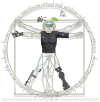Converging Robotic Technologies in Targeted Neural Rehabilitation: A Review of Emerging Solutions and Challenges
- PMID: 33809721
- PMCID: PMC8002299
- DOI: 10.3390/s21062084
Converging Robotic Technologies in Targeted Neural Rehabilitation: A Review of Emerging Solutions and Challenges
Abstract
Recent advances in the field of neural rehabilitation, facilitated through technological innovation and improved neurophysiological knowledge of impaired motor control, have opened up new research directions. Such advances increase the relevance of existing interventions, as well as allow novel methodologies and technological synergies. New approaches attempt to partially overcome long-term disability caused by spinal cord injury, using either invasive bridging technologies or noninvasive human-machine interfaces. Muscular dystrophies benefit from electromyography and novel sensors that shed light on underlying neuromotor mechanisms in people with Duchenne. Novel wearable robotics devices are being tailored to specific patient populations, such as traumatic brain injury, stroke, and amputated individuals. In addition, developments in robot-assisted rehabilitation may enhance motor learning and generate movement repetitions by decoding the brain activity of patients during therapy. This is further facilitated by artificial intelligence algorithms coupled with faster electronics. The practical impact of integrating such technologies with neural rehabilitation treatment can be substantial. They can potentially empower nontechnically trained individuals-namely, family members and professional carers-to alter the programming of neural rehabilitation robotic setups, to actively get involved and intervene promptly at the point of care. This narrative review considers existing and emerging neural rehabilitation technologies through the perspective of replacing or restoring functions, enhancing, or improving natural neural output, as well as promoting or recruiting dormant neuroplasticity. Upon conclusion, we discuss the future directions for neural rehabilitation research, diagnosis, and treatment based on the discussed technologies and their major roadblocks. This future may eventually become possible through technological evolution and convergence of mutually beneficial technologies to create hybrid solutions.
Keywords: artificial intelligence; brain–computer interfaces; exoskeleton; human–robot interaction; neural interfaces; neurological disability; neurorehabilitation; robotics.
Conflict of interest statement
The authors declare that the research was conducted in the absence of any commercial or financial relationships that could be construed as a potential conflicts of interest.
Figures




Similar articles
-
Artificial intelligence in stroke rehabilitation: From acute care to long-term recovery.Neuroscience. 2025 Apr 19;572:214-231. doi: 10.1016/j.neuroscience.2025.03.017. Epub 2025 Mar 9. Neuroscience. 2025. PMID: 40068721 Review.
-
NeuroSuitUp: System Architecture and Validation of a Motor Rehabilitation Wearable Robotics and Serious Game Platform.Sensors (Basel). 2023 Mar 20;23(6):3281. doi: 10.3390/s23063281. Sensors (Basel). 2023. PMID: 36991992 Free PMC article.
-
AI Applications in Adult Stroke Recovery and Rehabilitation: A Scoping Review Using AI.Sensors (Basel). 2024 Oct 12;24(20):6585. doi: 10.3390/s24206585. Sensors (Basel). 2024. PMID: 39460066 Free PMC article.
-
Exploring the Use of Brain-Computer Interfaces in Stroke Neurorehabilitation.Biomed Res Int. 2021 Jun 18;2021:9967348. doi: 10.1155/2021/9967348. eCollection 2021. Biomed Res Int. 2021. PMID: 34239936 Free PMC article. Review.
-
Robotic devices and brain-machine interfaces for hand rehabilitation post-stroke.J Rehabil Med. 2017 Jun 28;49(6):449-460. doi: 10.2340/16501977-2229. J Rehabil Med. 2017. PMID: 28597018 Review.
Cited by
-
Enhanced neuroplasticity and gait recovery in stroke patients: a comparative analysis of active and passive robotic training modes.BMC Neurol. 2025 May 31;25(1):239. doi: 10.1186/s12883-025-04226-0. BMC Neurol. 2025. PMID: 40450196 Free PMC article. Clinical Trial.
-
Traumatic Brain Injury: Novel Experimental Approaches and Treatment Possibilities.Life (Basel). 2025 May 30;15(6):884. doi: 10.3390/life15060884. Life (Basel). 2025. PMID: 40566538 Free PMC article. Review.
-
Ethics and Automated Systems in the Health Domain: Design and Submission of a Survey on Rehabilitation and Assistance Robotics to Collect Insiders' Opinions and Perception.Healthcare (Basel). 2022 Apr 22;10(5):778. doi: 10.3390/healthcare10050778. Healthcare (Basel). 2022. PMID: 35627915 Free PMC article.
-
Comment on Anwer et al. Rehabilitation of Upper Limb Motor Impairment in Stroke: A Narrative Review on the Prevalence, Risk Factors, and Economic Statistics of Stroke and State of the Art Therapies. Healthcare 2022, 10, 190.Healthcare (Basel). 2022 May 5;10(5):846. doi: 10.3390/healthcare10050846. Healthcare (Basel). 2022. PMID: 35627983 Free PMC article.
-
Therapeutic robots for post-stroke rehabilitation.Med Rev (2021). 2024 Feb 27;4(1):55-67. doi: 10.1515/mr-2023-0054. eCollection 2024 Feb. Med Rev (2021). 2024. PMID: 38515779 Free PMC article. Review.
References
-
- Belda-Lois J.M., Horno S.M.-D., Bermejo-Bosch I., Moreno J.C., Pons J.L., Farina D., Iosa M., Molinari M., Tamburella F., Ramos-Murguialday A., et al. Rehabilitation of gait after stroke: A review towards a top-down approach. J. Neuroeng. Rehabil. 2011;8:66. doi: 10.1186/1743-0003-8-66. - DOI - PMC - PubMed
Publication types
MeSH terms
Grants and funding
LinkOut - more resources
Full Text Sources
Other Literature Sources
Medical

